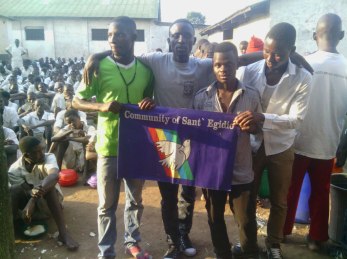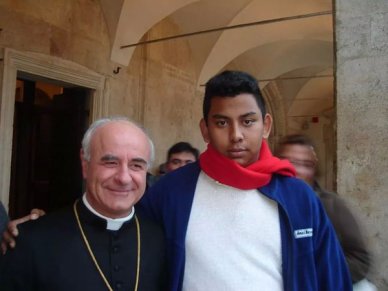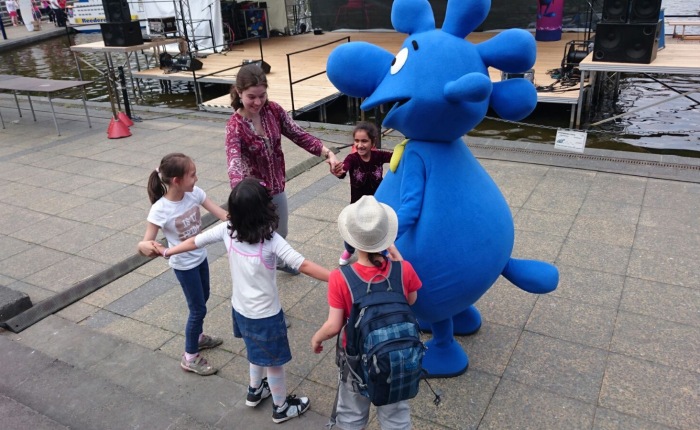Luisa Banchoff, Princeton, NJ
Community of Sant’Egidio | September 3, 2016
What do we mean when we say that something “makes” our day? I often find that it only takes a friendly smile from a fellow student on my way to class, a shared laugh with another person, or a trusted friend whose patience and attentiveness is the perfect remedy to a difficult problem I’ve been faced with on a given day. In instances like these, the presence of another person – however brief and superficial the interaction with them may seem – lifts me out of my routine, which is all too often framed by a stress-infused list of uncompleted tasks. When I open myself up to the moment and allow myself to mirror the other person’s smile or laugh, my other tasks cede ground to the immediacy of the present. The connection offers me a small happiness, and in doing so it helps me realize how my happiness is tied up with other people. Our lives are far more interdependent than we might initially realize.
As I return to my college campus this fall and gear up for senior year, I look forward to instances like these – indeed, from past experience I know that these small moments of happiness can be a deciding factor in how my day shapes up. But what if there was another way of having my day be made, one that depended less on discrete happy moments and more on a steady foundation of joy?
This is the joy I experienced in the Community of Sant’Egidio earlier this year, when I studied abroad in Berlin, Germany. My experience in the Community there began with several discrete memories – my first time at prayer, my first visit to the School of Peace, my first dinner with friends from the Community. Looking back on my journal, these days are early to spot – my entries always begin with exultations of glee accompanied by a copious amount of exclamation points. Over time, however, it became clear that my experience could not be easily reduced to happy moments or happy days – and not just because there were so many of them. Rather, those months in Berlin were infused with an intense joy, even on those days that lacked specific moments of happiness. The joy was not just an emotion. Gradually, it became a way of seeing the world around me. Every interaction became the opportunity to practice joy by opening myself up to others, giving people the benefit of the doubt, and reaching out to people I would not otherwise speak to. In short, the embrace of the Community’s friendship empowered me to navigate each day with a warmth, openness, and ambition to be kind that I had never before known I was capable of.
It all began on a single day: April 12. I hurried into Heilige Familie, the church in Prenzlauer Berg where the Community has their prayer every Tuesday evening. As I headed towards a pew, I was immediately comforted by the familiar icon resting on the alter. I had first heard about Sant’Egidio two years earlier, and last summer I’d spent two months in Rome with the Community. So even in this new city, I felt like I was returning to a familiar and cherished place. After prayer I was greeted with about a dozen warm handshakes and hugs, and I began the long process of learning the names of the Community here – names that would come to mean so much to me. They are Tobi, Musia, Ludwig, Maria, Majd, Alexander, Xenia … and so many more.
April 12 ended with a family dinner with five new friends at a local Italian restaurant. It was the first of a series of wonderful days, followed by Friday, April 15, when Musia invited me to the School of Peace in a refugee home at the edge of the city. Soon the individual days gave way to weeks and months of joyful, hilarious, and fulfilling memories. One day stands out in particular: May 28.
May 28 began with a groggy cup of tea and an ambitious plan. Musia and I sat at the small table in the kitchen of her apartment, breakfasting on the last slice of bread in the loaf. We had already called Majd to go over the day’s excursion: we were to meet outside the refugee home around nine, then pick up “our children,” six girls from the School of Peace. From there we would first take the bus, then the S-Bahn (Berlin’s citywide railway), and then the tram before arriving at our destination. After downing the last of our tea and gathering ourselves, Musia and I headed out, somehow already quite tired. Little did we know how happily exhausted the day would leave us.
Our trip to the refugee home culminated in a bus ride through Falkenberg, a quiet and unassuming corner of the city far from the metropolitan center. Just around the corner from the bus stop, the refugee home came into sight: a building composed of shipping containers stacked three stories high. As we made our way past the entrance, we were greeted by a wave of children’s voices whose energy defied the fact that it was a Saturday morning. One after the other they launched themselves at us – Somaiye, Mahdiya, Sara, Yasemin, Mohadissa. And Nazanin, the oldest of the bunch, whose calming effect on the other girls made it hard to believe that she was just twelve. Since Nazanin had been unable to go to the School of Peace’s summer camp two weeks earlier, Musia had promised her a weekend excursion with her sister Yasemin and several other kids. Our day was to be the fulfillment of that promise – and so much more. After checking in with the girls’ parents and confirming we’d be back around four, our troupe headed out to the bus stop, each of us hand-in-hand with two girls.
I could write an entire blog post lauding Berlin’s public transportation system – it is truly wonderful – but that’s probably because I had so many fun experiences playing games with the kids from the School of Peace while riding the tram or S-Bahn! Today was no exception. With patty-cake, charades, and pictionary (using air instead of a notepad), we quickly passed the hour-long trip – and managed to get some fellow riders to crack a grin at our cheerful antics. By the time the tram rolled up to our stop, I too was laughing quite a bit, filled with an energy that came more from the kids than from the tea.
We had arrived at the Freizeit- und Erholungszentrum, better known as the FEZ (pronounced faytz), a massive recreational center and park situated in a large stretch of woods in the east of Berlin. It boasted a fully functional mini-railroad that ran a loop around the park, an indoor swimming pool, an artificial lake with inflatable boats and a floating stage, and playgrounds all around – one of which we bolted for as soon as we passed through the gates. While Musia went to get our tickets, Majd and I cheered on the girls as they took turns on the large metal slide. We did a lot of cheering that day – we cheered each other on when we found ourselves in a precarious wooden boat contraption, pulling on a rope to get ourselves across the artificial lake. We cheered when we figured out how to navigate the small inflatable boats on the same lake (something I was no good at; were it not for Nazanin and Mahdiya rowing alongside me I would have surely been stranded!). And we cheered when the girls got a personal picture with Theo, the FEZ mascot, a funny blue blob that appeared to be a dinosaur/blueberry hybrid. (Turns out he’s an inkblot!)
Theo’s timing was perfect – we had wanted a picture with him all along, but the day was already winding down and soon we’d have to be back on our way home. Yet we were not leaving just yet – Theo would make sure of that. Hand-in-hand with Yasemin and Sahra, he led us to the steps in front of the floating stage and motioned for us to sit down. Musia, Majd, and I looked at one another hesitantly – didn’t we say we’d be back by four? Hadn’t we promised the kids ice cream before then? Yet before we could rally the troops, Yasemin had jumped up and eagerly grabbed Theo’s hands. Music was playing and she was determined to dance. She shrugged off her pink backpack and joined hands with Theo for “Come On Eileen,” spinning around and laughing with the biggest smile I’d ever seen on a kid’s face.
Watching Yasemin dance, the joy of the day crested within me. What could be more beautiful than this girl’s carefree smile and gleeful laughter? What could better make my day? Right then and there, I felt as if I had been offered a rare and striking glimpse of clarity: there was no more fitting place in the world for me at that moment but on this step, in this park, with these friends, on this day, May 28. My joy was not merely a result of Yasemin’s smile, nor was it reducible to a single event from the day. It was much more due to the fact that I had gotten to know Yasemin over the past weeks: I had gotten to know what it meant for Yasemin to smile the way she was just then. I had begun to grasp how the foundation of a joyful life is built on constantly being in relationship with others, growing with them through challenges and triumphs alike.
And, as Yasemin herself recognized, joy is magnified when it is shared. Before I could muse for too long, she grabbed my hand. Soon Mahdiya, Mohadissa and I were dancing with her, Theo, and another girl who had been watching eagerly us from close by.
As with many of my memories from my time with the Community in Berlin, the intensity of the joy I felt at that moment refuses to be easily forgotten. Musia, Majd, and I would recall Yasemin dancing to the tune of “Come On Eileen” many times over in the following months. (And I won’t soon forget the taste of the chocolate ice cream that Musia and Majd had snuck off to fetch while we’d been dancing!) Of course, many details of May 28 have faded in the time since then. Yet the consistent, outward-moving joy that Sant’Egidio fostered in me through my friendships with Nazanin, Sahra, Majd, and Musia – to name a few – was a constant source of comfort and empowerment for me even on difficult or unhappy days. With deep gratitude and joyful energy as my default, I felt that even the simplest of actions on the most ordinary of days could reflect the life-giving call of the gospel.
Saying goodbye to Nazanin and Mohadissa, Yasemin and Somaiye, Mahdiya and Sahra, and dozens of other friends was one of the unhappiest tasks I’ve had to face in my life. Yet I hope to return to Berlin again soon. Until then, I am searching for ways to incorporate Sant’Egidio into my life, such as starting a group on my campus. And though they are an ocean away, I know that my friends in Berlin are not so far from me. I call upon them every day when I make an effort to recognize the countless sources of joy in my life – those from Berlin, my school, my home, and everywhere where I have friends who have changed my heart. I know they will continue to make my day for many days to come.
And I know I will never again listen to “Come On Eileen” without reliving the joy of May 28.
This slideshow requires JavaScript.
 It took place in Malawi, in Blantyre, at the College of Medicine, the First National Day of the Communities of Sant’Egidio present in the various universities of the country. The Community of Sant’Egidio has been present for many years in the academic world of the small sub-Saharan country. Young people commit every month in the visit to the elderly who live around their campus and organize fundraising iniciatives to help prisoners in prisons. In the big Prison of Makande, near Tchoda, it was recently held a luncheon organized by the Community of the Sciences and Communications for 336 prisoners (see photo).
It took place in Malawi, in Blantyre, at the College of Medicine, the First National Day of the Communities of Sant’Egidio present in the various universities of the country. The Community of Sant’Egidio has been present for many years in the academic world of the small sub-Saharan country. Young people commit every month in the visit to the elderly who live around their campus and organize fundraising iniciatives to help prisoners in prisons. In the big Prison of Makande, near Tchoda, it was recently held a luncheon organized by the Community of the Sciences and Communications for 336 prisoners (see photo). 500 hundreds young people participated in the Day from different colleges to reflect, in the light of the “spirit of Assisi“, on the role of young college students in the construction of a culture of living together and the attention to the poorest. Jane Gondwe, coordinator of the DREAM Centre in Blantyre, Illustrated the path of the DREAM program in Malawi remembering “the dream of raising a generation free from AIDS burden” and the great “opportunities for all, in a globalized world, to do something for the Resurrection of Africa “.
500 hundreds young people participated in the Day from different colleges to reflect, in the light of the “spirit of Assisi“, on the role of young college students in the construction of a culture of living together and the attention to the poorest. Jane Gondwe, coordinator of the DREAM Centre in Blantyre, Illustrated the path of the DREAM program in Malawi remembering “the dream of raising a generation free from AIDS burden” and the great “opportunities for all, in a globalized world, to do something for the Resurrection of Africa “. Father Ernest Kafunsa, Parish priest in Blantyre, invited the young people not to be carried away by the “myth of success at all costs” and to look around to find out the cry for help that comes from many elderly, children and prisoners in the country “, which is small, we think we know it and instead it escapes us because we do not know to stop. ” The meeting was concluded by Professor Denis Mwaungulu, judge of the Supreme Court of Malawi, who focused on the need for Malawi and for the whole of Africa, to grow a civil society that show and realize the values of honesty and of selfless dedication to the public good. The magistrate recalled the biblical figure of Joseph who, “though not the Egyptian found in Egypt a public role, he became a good leader because he was a spiritual and deep person.” The conference concluded with an invitation to all to organize moments of prayer for peace open to all student in their own colleges.
Father Ernest Kafunsa, Parish priest in Blantyre, invited the young people not to be carried away by the “myth of success at all costs” and to look around to find out the cry for help that comes from many elderly, children and prisoners in the country “, which is small, we think we know it and instead it escapes us because we do not know to stop. ” The meeting was concluded by Professor Denis Mwaungulu, judge of the Supreme Court of Malawi, who focused on the need for Malawi and for the whole of Africa, to grow a civil society that show and realize the values of honesty and of selfless dedication to the public good. The magistrate recalled the biblical figure of Joseph who, “though not the Egyptian found in Egypt a public role, he became a good leader because he was a spiritual and deep person.” The conference concluded with an invitation to all to organize moments of prayer for peace open to all student in their own colleges. Today is the 7th anniversary of the death of William Quijano, a young man of the Community of Sant’Egidio in El Salvador who was killed at the age of 21 in 2009 because of his work in the School of Peace with children in a difficult periphery of San Salvador.
Today is the 7th anniversary of the death of William Quijano, a young man of the Community of Sant’Egidio in El Salvador who was killed at the age of 21 in 2009 because of his work in the School of Peace with children in a difficult periphery of San Salvador.